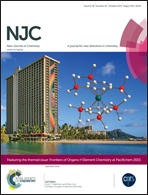Pyrenyl-functionalized ferrocenes for multisignaling recognition of anions†
Abstract
New mono- and di-substituted pyrene-appended ferrocenes bearing amide or amide–sulfonamide binding sites, 1–4, have been synthesized, and their anion recognition abilities have been investigated. In CH3CN solution, all receptors show distinctive electrochemical sensing of F− and H2PO4− with a large cathodic shift in the ferrocene/ferrocenium redox potential, with 4 showing the strongest anion binding ability. In addition, receptors 3 and 4 bearing amide–sulfonamide binding sites also exhibit fluorescence response to AcO− and H2PO4− with a large enhancement in their emission intensity. The binding mechanisms between 3 and anions are also investigated by 1H NMR titration and DFT calculations.


 Please wait while we load your content...
Please wait while we load your content...